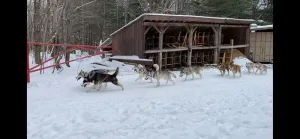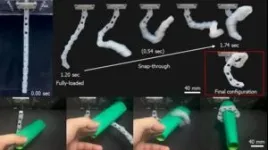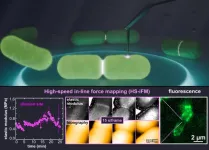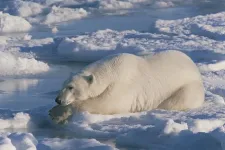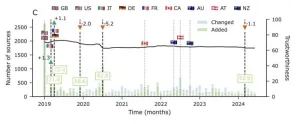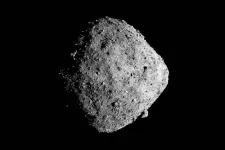(Press-News.org) Working dogs take a day to adjust to the change in routine caused by Daylight Savings Time, whereas pet dogs and their owners seem to be unaffected, according to a study publishing January 29, 2025 in the open-access journal PLOS One by Lavania Nagendran, Ming Fei Li and colleagues at the University of Toronto, Canada.
Daylight Savings Time (DST) is used by many countries to maintain the alignment between daylight hours and human activity patterns, by setting clocks forward one hour in the spring and back one hour in the autumn. Previous research has shown that DST can disrupt human sleep and behavior, but its impact on the domestic animals we live and work with had not been studied.
To investigate how DST impacts domestic dogs (Canis familiaris), researchers used motion-sensitive watches to monitor the activity patterns of 25 working sled dogs, 29 pet dogs, and their human caregivers living in Canada, during the weeks surrounding the autumn DST time shift.
For sled dogs, DST represented a change to their strict daily routine. Prior to the time shift, sled dog handlers arrived at the reserve at sunrise, but after DST came into effect, sunrise was an hour before their arrival. As a result of this mismatch, after the DST time shift, sled dogs were less active in the hour after sunrise than they were before the shift. However, they didn’t immediately adjust to the change in their routine. On the day that DST came into effect, sled dogs were more active than usual in the hour prior to their handler’s arrival.
In contrast, pet dogs and their owners showed no change in their morning activity patterns on the Sunday that DST came into effect. After DST, even though pet owners woke up earlier on weekdays, their pet dogs did not change their morning behavior. However, age had a significant influence on the dogs’ response to DST, and older pet dogs were less active on the first morning after the time shift.
The study is the first to investigate the impact of Daylight Savings Time on domestic dogs’ activity. Changes to human schedules can have a ripple effect through the daily lives of dogs, which may affect their well-being. The findings highlight the importance of flexibility and gradual changes to help dogs adjust to modifications to their daily routine, the authors say.
The authors add: “Our study comparing companion and sled dogs finds that flexible routines can help dogs better adjust to abrupt schedule changes like Daylight Saving Time.”
In your coverage, please use this URL to provide access to the freely available article in PLOS One: https://journals.plos.org/plosone/article?id=10.1371/journal.pone.0317028
Citation: Nagendran L, Li MF, Samson DR, Schroeder L (2025) The impact of Daylight Saving Time on dog activity. PLoS ONE 20(1): e0317028. https://doi.org/10.1371/journal.pone.0317028
Author countries: Canada
Funding: This research was supported through Discovery Grants from the Natural Sciences and Engineering Research Council of Canada (RGPIN-2020-04159 to L.S. and RGPIN-2020-05942 to D.R.S).
END
Working dogs take a day to adjust to Daylight Savings Time, but pets are more flexible
Sled dogs in a Canadian facility were more active than usual the morning after the clocks turned back
2025-01-29
ELSE PRESS RELEASES FROM THIS DATE:
Reviews of movies with female- versus male-dominated casts found to contain more sexist language
2025-01-29
In a new linguistic analysis, reviews of movies with female-dominated casts were found to have significantly higher levels of sexism than reviews of movies with male-dominated casts. Jad Doughman and Wael Khreich of the American University of Beirut, Lebanon, present these findings in the open-access journal PLOS One, on January 29, 2025.
Prior research suggests that negative movie reviews can affect actors’ finances, career paths, and mental well-being, while also influencing the broader media landscape. However, studies of gender bias in reviews have traditionally relied on movie ratings or box-office ...
Women exercising in gyms often face barriers including body image and harassment
2025-01-29
When exercising in gyms, women face barriers across various domains, including physical appearance and body image, gym attire, the physical gym environment, and interactions with others, according to a study published January 29, 2025, in the open-access journal PLOS One by Emma Cowley from the SHE Research Centre, TUS, Ireland, and Jekaterina Schneider from the University of the West of England, U.K.
Exercise significantly improves physical, mental, and psychosocial health. Recent research indicates that women who engage in regular exercise experience greater health benefits than men, including lower incidence of all-cause mortality and reduced ...
SNU researchers apply the principles of mantis shrimp and fleas to create soft robots with powerful movements
2025-01-29
Seoul National University College of Engineering announced that a research team led by Professor Kyu-Jin Cho (Director of the Soft Robotics Research Center) from the Department of Mechanical Engineering took inspiration from principles found in nature and developed the "Hyperelastic Torque Reversal Mechanism (HeTRM)," which enables robots made from rubber-like soft materials to perform rapid and powerful movements. This study was published in the prestigious international journal Science Robotics on January 29.
The mantis shrimp delivers a punch ...
Quantum-inspired computing drives major advance in simulating turbulence
2025-01-29
UNDER EMBARGO UNTIL 19:00 GMT / 14:00 ET, WEDNESDAY 29 JANUARY 2025
Quantum-inspired computing drives major advance in simulating turbulence
Researchers at the University of Oxford have pioneered a new approach to simulate turbulent systems, based on probabilities. The findings have been published today (29 January) in the journal Science Advances.
Predicting the dynamics of turbulent fluid flows has long been a central goal for scientists and engineers. Yet, even with modern computing technology, direct and accurate simulation of all but the simplest turbulent flows remains impossible.
This is due to turbulence being ...
New microscopy technique reveals dynamic Escherichia coli membrane stiffness
2025-01-29
Light and electron microscopy have distinct limitations. Light microscopy makes it difficult to resolve smaller and smaller features, and electron microscopy resolves small structures, but samples must be meticulously prepared, killing any live specimens.
Atomic force microscopy (AFM) is a technique originally developed to assess the physical and mechanical properties of materials at extremely high resolutions, but the imaging speeds aren’t fast enough (e.g. several minutes per frame) to capture relevant data for living biological samples. In contrast, another method, high-speed AFM (HS-AFM), is fast but cannot measure mechanical properties. Understanding ...
Bad hair bears! Greasy hair gives polar bears fur with anti-icing properties
2025-01-29
An international team of scientists has discovered the anti-icing secret of polar bear fur – something that allows one of the planet’s most iconic animals to survive and thrive in one of its most punishing climates. That secret? Greasy hair.
After some polar sleuthing, which involved scrutiny of hair collected from six polar bears in the wild, the scientists homed in on the hair “sebum” (or grease) as the all-important protectant. This sebum, which is made up of cholesterol, diacylglycerols, and fatty acids, makes it very hard for ice to attach to their fur.
While this finding ...
Materials can remember a sequence of events in an unexpected way
2025-01-29
UNIVERSITY PARK, Pa. — Many materials store information about what has happened to them in a sort of material memory, like wrinkles on a once crumpled piece of paper. Now, a team led by Penn State physicists has uncovered how, under specific conditions, some materials seemingly violate underlying mathematics to store memories about the sequence of previous deformations. According to the researchers, the method, described in a paper appearing today (Jan. 29) in the journal Science Advances, could inspire new ways to store information in ...
NewsGuard: Study finds no bias against conservative news outlets
2025-01-29
[Vienna, 29.01.2025]—A recent study evaluating the NewsGuard database, a leading media reliability rating service, has found no evidence supporting the allegation that NewsGuard is biased against conservative news outlets. Actually, the results suggest it’s unlikely that NewsGuard has an inherent bias in how it selects or rates right-leaning sources in the US, where trustworthiness is especially low.
“It seems unlikely that NewsGuard has an inherent bias against conservative sources, both in selecting and giving them lower ratings. Instead, the US media system is flooded with right-wing sources that tend to not adhere to professional ...
New tool can detect fast-spreading SARS-COV-2 variants before they take off
2025-01-29
By analysing millions of viral genome sequences from around the world, a team of scientists, led by the Peter Doherty Institute for Infection and Immunity (Doherty Institute) and the University of Pittsburgh, uncovered the specific mutations that give SARS-CoV-2 a ‘turbo boost’ in its ability to spread.
“Among thousands of SARS-CoV-2 mutations, we identified a small number that increase the virus’ ability to spread,” said Professor Matthew McKay, a Laboratory Head at the Doherty Institute and ARC Future Fellow in the Department of Electrical and Electronic Engineering at the University of Melbourne, and co-lead author of the ...
Berkeley Lab helps explore mysteries of Asteroid Bennu
2025-01-29
During the past year, there’s been an unusual set of samples at the Department of Energy’s Lawrence Berkeley National Laboratory (Berkeley Lab): material gathered from the 4.5-billion-year-old asteroid Bennu when it was roughly 200 million miles from Earth.
Berkeley Lab is one of more than 40 institutions investigating Bennu’s chemical makeup to better understand how our solar system and planets evolved. In a new study published today in the journal Nature, researchers found evidence that Bennu comes from an ancient wet world, with some material from the coldest regions of the solar system, likely beyond the orbit of ...
LAST 30 PRESS RELEASES:
Chicago health information leader recognized for raising CPR readiness and blood pressure awareness
The Intimate Animal, a new book from Kinsey Institute Executive Director Dr. Justin Garcia
When blue-collar workers lose union protection, they try self-employment
New video dataset to advance AI for health care
MEA-based graph deviation network for early autism syndrome signatures in human forebrain organoids
New modeling approach sheds light on rare gut disease
Study documents potentially hazardous flame retardants in firefighter gear
Can certain bacteria regulate aging of the immune system and its related alterations?
AI model helps diagnose often undetected heart disease from simple EKG
There are fewer online trolls than people think
Cell membrane fluctuations produce electricity
Jeonbuk National University study shows positive parenting can protect adolescents against self-harm
Surface-engineered ZnO nanocrystals to tackle perfluoroalkyl substance contamination
This new understanding of T cell receptors may improve cancer immunotherapies
A new fossil face sheds light on early migrations of ancient human ancestor
A new immunotherapy approach could work for many types of cancer
A new way to diagnose deadly lung infections and save lives
40 percent of MRI signals do not correspond to actual brain activity
How brain-inspired algorithms could drive down AI energy costs
Gum disease may be linked to plaque buildup in arteries, higher risk of major CVD events
Contrails are a major driver of aviation’s climate impact
Structure of dopamine-releasing neurons relates to the type of circuits they form for smell-processing
Reducing social isolation protects the brain in later life
Keeping the heart healthy increases longevity even after cancer
Young adults commonly mix cannabis with nicotine and tobacco
Comprehensive review illuminates tau protein's dual nature in brain health, disease, and emerging psychiatric connections
Book prepares K-12 leaders for the next public health crisis
Storms in the Southern Ocean mitigates global warming
Seals on the move: Research reveals key data for offshore development and international ecology
Sports injuries sustained during your period might be more severe
[Press-News.org] Working dogs take a day to adjust to Daylight Savings Time, but pets are more flexibleSled dogs in a Canadian facility were more active than usual the morning after the clocks turned back
